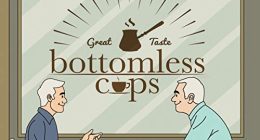Novels-in-stories contain their own specific joys. One is the sense of partnership they can foster between the reader and the book. In the “off-camera” time between story-chapters, the reader gets to fill in what transpires. As a writer, it takes trust to leave that space—a kind of trust the reader can feel. In writing my book, I knew that I didn’t have to drop into every wedding, job change, and birth—it was the smaller, more idiosyncratic moments I was interested in. Those unwritten gaps can also create a feeling of on-goingness. It isn’t a coincidence that two of the most popular examples of the genre, both Jennifer Egan’s A Visit from the Goon Squad and Elizabeth Strout’s Olive Kitteridge, have sequels. The reader knows the characters’ lives are happening between the pages, so can imagine them continuing to do so after the book ends. Conversely, novels-in-stories also deliver the satisfaction of multiple endings. For me, the best part of writing my book was working toward the magic of a perfect ending sixteen times rather than just one.
My book, Choose This Now, follows best friends Val-and-Tal across nearly twenty years as they navigate friendship, art, and motherhood, as well as the intersections between them. It is a quiet, introspective book, so when readers began to compare it to the virtuosic A Visit from the Goon Squad, I suspected they weren’t referring to my Pulitzer-Prize-quality writing so much as our books shared form. Although my approach to this hybrid genre is very different from Egan’s, the comparison persists because the label “novel-in-stories” is so rarely used. Even A Visit from the Goon Squad, as classic an example of a novel-in-stories as I can imagine—each story-chapter stands on its own, but, read in order, builds to a larger arc—is emblazoned with the word novel on its cover. Ditto Olive Kitteridge. It seems defensive, as if publishers think readers won’t take a book seriously unless it is unequivocally a novel.
Listed here are ten books that read as novels-in-stories, no matter how they’ve been marketed. Rather than drawing a line around them to separate them from novels or story collections, I hope to share that they are both/and—books that embrace the in-between.
Black Sheep Boy by Martin Pousson
Unlike many novels-in-stories that use the form to bounce between several protagonists, Martin Pousson’s book centers a single character. Boo, though, contains multitudes. Queer and Cajun, growing up in the Louisiana Bayou, he is book smart and earnest, often incapable of playing it cool, but also a fierce friend, able to unleash his voice at just the moment it is most powerful. The book gives us the multifaceted, often painful history of the world into which Boo is born and follows him from early childhood through young adulthood. As he grows, Boo learns too much too soon at the hands of older boys and men. There is a hunted, haunted terror to parts of the book where the predators come in the shape of golden boys next door and a teacher named Mr. Hedgehog, but there is also friendship, community, and connection. A poet as well as a fiction writer, Pousson’s prose ranges from raw to rhapsodic, as evidenced by the bold, beautiful rhyme that ends the book’s eponymous short story: “Under his cloak, we lay together, and no one could tell the black sheep from the white or the field of stars from the dome of night.” While each story is complete and lyrically stunning on its own, together, the atmosphere of the bayou builds to a rich context and the reader’s knowledge of Boo’s past makes each subsequent moment that much more resonant.
Night of the Living Rez by Morgan Talty
Morgan Talty’s Night of the Living Rez takes place on the Penobscot Indian Island Reservation in Maine and alternates between two time frames, one in which its protagonist is a young adult, Dee, and one in which he is a child, David. In the first story, “Burn,” Dee is skulking away from an attempt to buy pot when he hears moaning coming from a frozen swamp. He spots his friend, Fellis, emerging from a stupor to find his long hair embedded in the ice. An unforgettable image, it is both slapstick and tragic. Dee and Fellis spiral through addiction, lack of opportunity, and generational trauma, getting into scrapes and dreaming up schemes. Do some of their troubles stem from David unwittingly unearthing a curse in the second story? The final chapter further complicates the book’s fragmented chronology, crystallizing an episode that casts both backward across the book and forward across David’s life, to utterly harrowing, yet narratively satisfying, effect. Night of the Living Rez can be devastating, but it is also propelled by humor, exceptional dialogue, and quick, witty writing.
Craft: Stories I Wrote for the Devil by Ananda Lima
Ananda Lima’s wildly inventive novel-in-stories breaks all the rules. It starts twice. It mixes genres. It is about a writer. A writer whose relationship with the Devil is almost…healthy? There are cross-outs, Zoom calls, and ghosts. Some stories are structured so tightly a writing workshop wouldn’t have a single bone to pick with them, while the story “Idle Hands” is comprised entirely of writing workshop feedback letters, each more hilarious, but also backhanded, catty, and/or racist, than the last. The story “Antropófaga” features a machine vending snack-sized Americans. The story “Hasselblad: Triptych” reboots three times, as if seen through a prism. How do these incongruent styles and structures fit together to form a cohesive novel? They don’t, and through that marvelous tension and variation, they do.
How High We Go in the Dark by Sequoia Nagamatsu
Each story-chapter in How High We Go in the Dark illuminates a different facet of a new world created when climate change unleashes a plague from the Siberian permafrost. A particularly heart-breaking story is set at a euthanasia amusement park where parents bring their little ones—because this pandemic hits children the hardest—for one last beautiful day. In another story, a pig engineered to donate his organs to sick kids becomes too human: verbal, curious, compassionate. These and many other of the book’s premises could be salacious or even silly in the wrong hands, but Nagamatsu’s are the right hands. The book may be science fiction (although, is it? Nagamatsu started it in 2008, but readers today have been through both COVID and the hottest year on record…), but he keeps human emotion and relationships at its heart. Whether the stories are about starships, shapeshifting aliens, or a service that liquifies bodies and transforms them into ice sculptures, they are really about death, grief, and love.
Fiona and Jane by Jean Chen Ho
The ten stories in Jean Chen Ho’s Fiona and Jane are about those namesake characters, but the most important word in the book’s title isn’t the names—it is their connector. Fiona and Jane are best friends from the moment eight-year-old Fiona moves to California from Taiwan. While it is more surface-level similarities, like the convenience of Jane already speaking Fiona’s language, that draw them together at first, their friendship quickly becomes the real thing. The two of them are a unit. That is, until they’re not. When Fiona moves away after college, each young woman struggles without her other half, filling in the blank before or after the “and” with all the wrong people. Jane says of Fiona, “I still thought of her as my best friend, though more and more she was becoming a story to me, one whose plot I couldn’t make sense of because either I was missing information or maybe I’d forgotten something from before—something important—and it was too late to ask about it now, because it would mean admitting I hadn’t been paying attentions.” Presence and absence are themes in this book not only regarding the central duo, but also their relationships with their parents and a series of partners and friends for each of them. Never straying far from what Fiona and Jane mean to each other, Ho is still able to draw fully realized secondary characters, too.
Structurally, Fiona and Jane falls closer to the novel side of the novel-in-stories spectrum. It isn’t that a reader coming to the separate stories would necessarily know something was missing, but when the Fiona stories come together with the Jane stories, they all feel more complete.
Ms. Hempel Chronicles by Sarah Shun-Lien Bynum
Ms. Hempel Chronicles begins with a few stories firmly situating seventh grade English teacher Ms. Hempel within her school, cementing her identity and self-conception in relation to her noisy, sweet students. So, the next few stories shock the reader just as they would shock her kids: wait, Ms. Hempel exists outside of school? She has sex? And a fiancé? No way—Ms. Hempel was once a child herself? The book then returns to her life within the walls of her school, the small changes there that destabilize her, how she succeeds and fails, sees herself or doesn’t in the lives of the other teachers, and searches for her place in the social order just like her preteens do. The final story in the book skips ahead years, but it fills in a lot of blanks for the reader, and for Ms. Hempel herself. The book is brimming with hilarious and true depictions of teaching: “The eighth graders were banished to their homerooms. As they exited the auditorium, banging into everything they touched…” as well as the insecurities that come with it: “Amnesiac…It was a condition that sometimes afflicted her. She would turn her back to the class; she would forget everything. What is a noun? Who were the Pilgrims? And, more troubling, What was I saying? Or: How did I get here?” By the end of the book, the reader knows all of this about Ms. Hempel and much more.
Disappearing Earth by Julia Phillips
Disappearing Earth opens with the kidnapping of two little girls and then builds a world around their absence. Each story that follows takes on the life of a person in the girls’ community, Kamchatka, a remote Russian peninsula near Alaska. Organized by month, the book progresses across the year after the girls’ disappearance. The mystery and tragedy around that one crime is the book’s inciting incident and impetus, but the story-chapters reveal so much more than who dunnit, their scope both broad and deep. Phillips’s writing shapeshifts convincingly, bringing the reader into the world of a student dance troupe, the resigned grief of a second-time widow, or the shock of a middle-aged woman discovering the ways her body could betray her. Disappearing Earth also delves into the racial and ethnic complexities of the region—an indigenous girl is also missing, her kidnapping receiving considerably less attention than the white girls’. The structure of the book makes so much possible, like the slow accumulation of clues accessible to the reader but not necessarily the characters and a fascinating portrait of a place and its people.
New to Liberty by DeMisty Bellinger
New to Liberty by DeMisty Bellinger complicates the idea of what a novel-in-stories can be. If there is a traditional form that novels-in-stories follow, it isn’t what Bellinger does here, which she describes as a “novel in thirds.” Each section is set in a different decade—1966, then 1947, then 1933—and centers a different woman in rural Liberty, Kansas. Bellinger is deft at constructing unforgettable scenes, like the visceral discomfort of 1966’s Sissily, a young Black woman, having to share a bed with her white lover’s unwelcoming mother, the confusing mix of feelings 1947’s Nella experiences when a handsome white man in a Victorian wicker wheelchair whispers a compliment in her ear, or 1933’s Greta and her brother wiping dirt from the wrinkles on their mother’s face and scooping mud from the crevices of her body after she is caught in a brutal dust storm. Each of these sections is compelling and propulsive on its own, but the end of the book pulls them all together.
Light Skin Gone to Waste by Toni Ann Johnson
When Light Skin Gone to Waste opens, Dr. Philip Arrington is driving north from New York City toward a new life for him and his second wife, Velma, in the almost-entirely-white small town of Monroe, New York. The ten stories in the book move mostly between Phil, Velma, and their young daughter Maddie, with a few other voices brought in, like Maddie’s cousin and the family housekeeper. A major theme in the book is how parents’ choices affect their children, which the reader sees through the lasting damage done to the characters by the generations who came before them. The book’s heart is with Maddie, the only Black girl in her school and town—a deeply intentional choice by her parents—who longs for her cousin’s life in the parallel world of a mostly Black Long Island community, the cruelty of her classmates’ and neighbors’ racism not stifling, limiting, and terrifying her every day.
The episodic form of Light Skin Gone to Waste is key to the book’s power. When Maddie suffers a trauma on a family trip, it is essential that the reader knows exactly what happened while her parents only should know. Likewise, it would be easy for the reader to hate Philip and Velma if we only got their perspective on each other or Maddie’s on her parents. Because the reader has an intimacy with each of them, though, Johnson leaves the opportunity open to feeling empathy for these characters, even when they might not deserve it.










